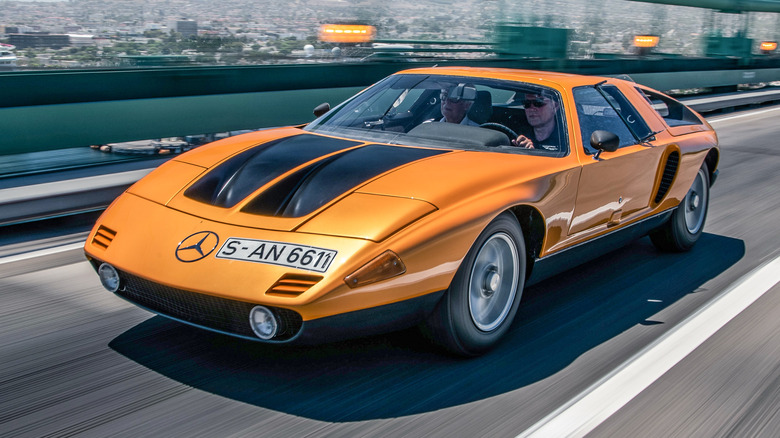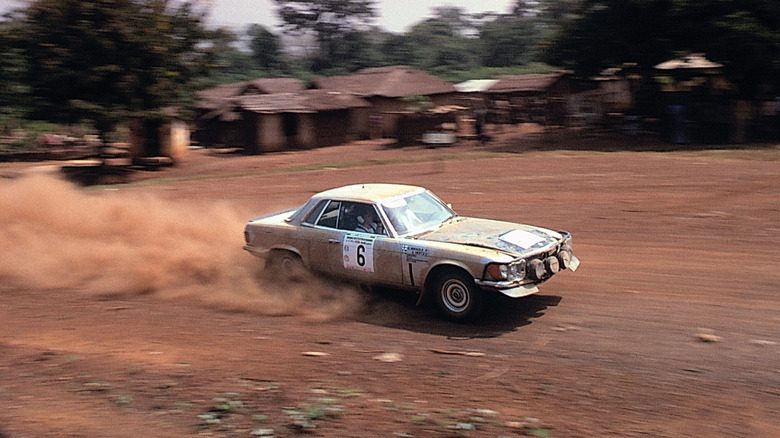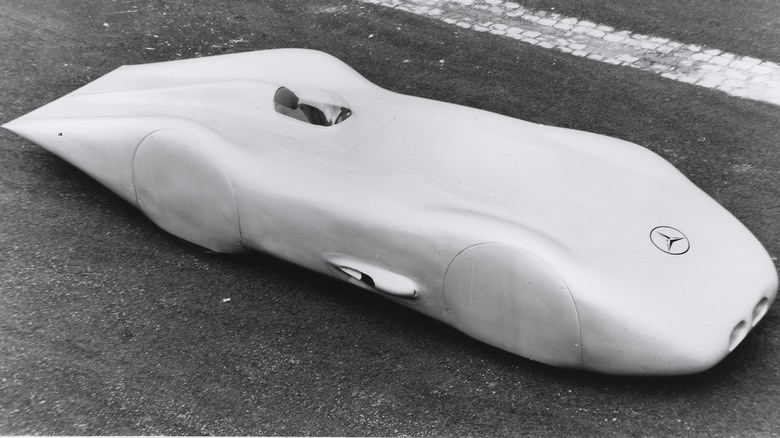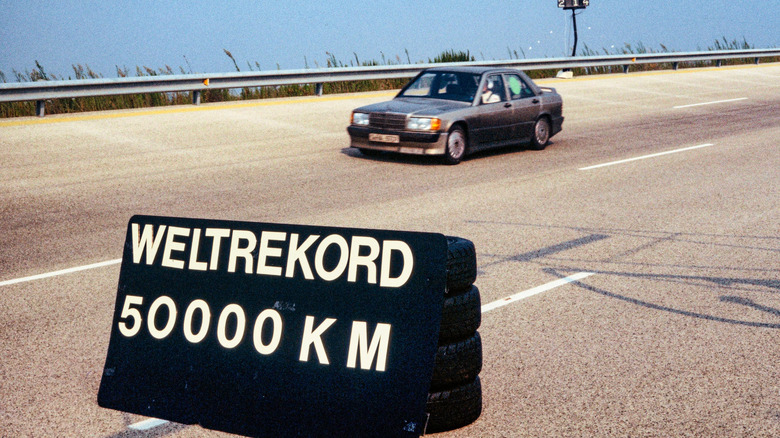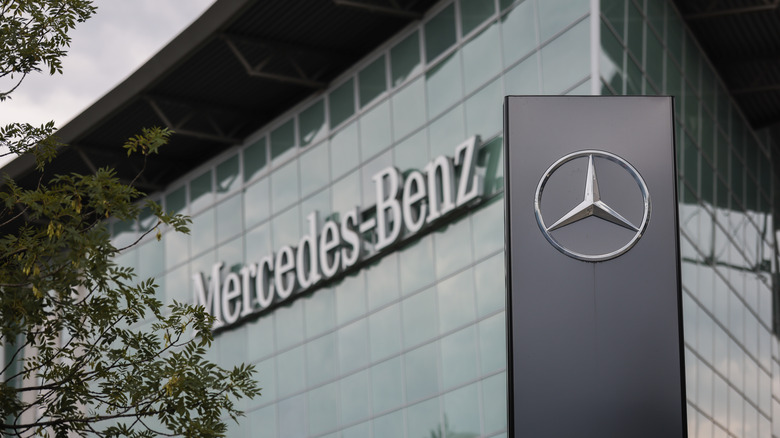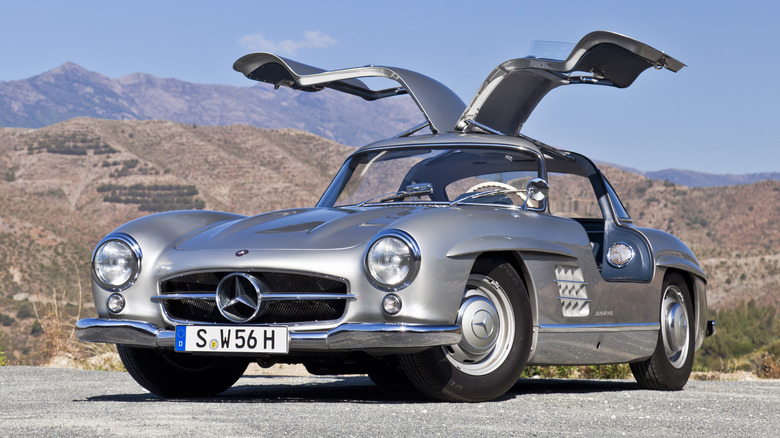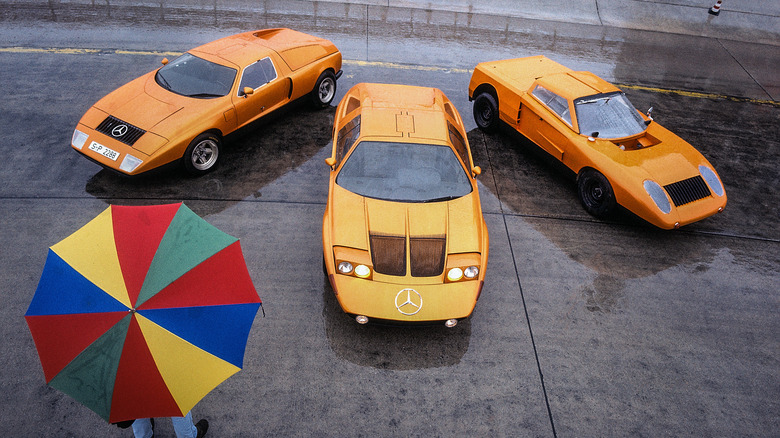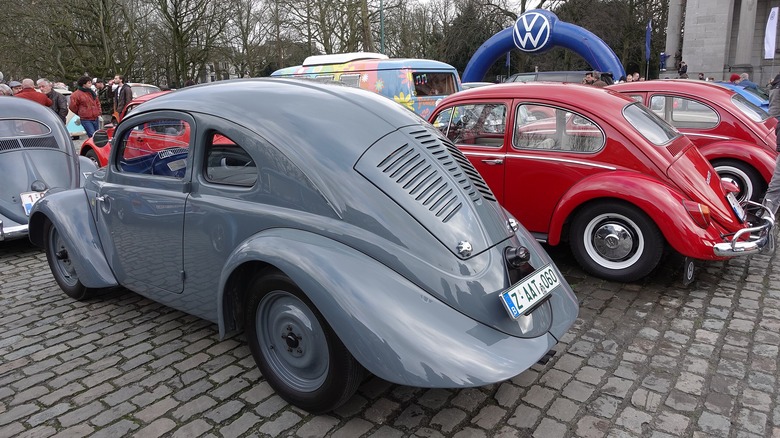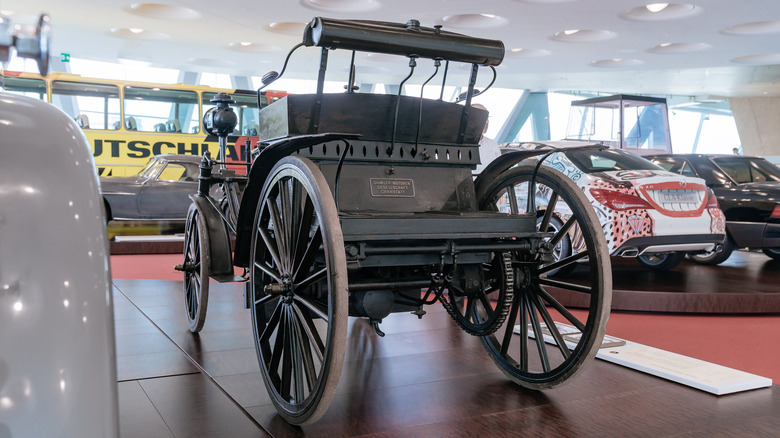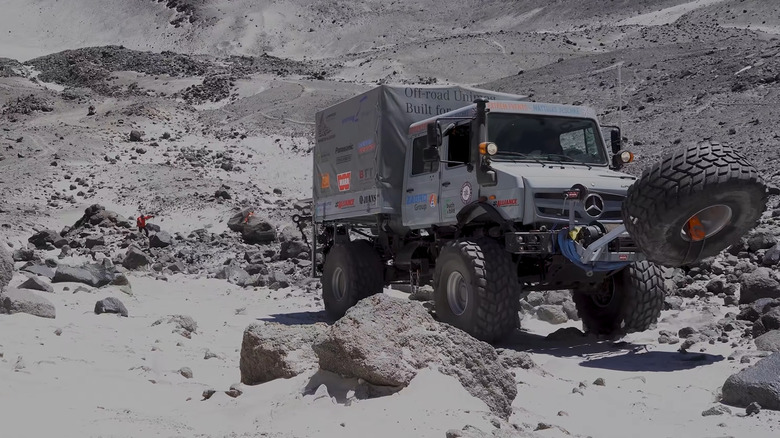10 Little-Known Facts About Mercedes Benz
The Mercedes-Benz three-pointed star logo can be found in all corners of the globe, and on a much wider range of vehicles than many would expect. The automaker's history of producing luxury limousines and ultra-expensive performance cars is well documented, but there's more to the story. While there are plenty of Mercedes-Benz cars and vans, the company makes everything from off-road fire trucks to aircraft parts. Not only that, but it has also helped produce several famous German cars sold under other brands, including one of the best-selling cars of all time.
In recent years the company has been in the midst of a major transition, pivoting away from its traditional combustion engines and toward a new, rapidly expanding range of electric vehicles. As the company rolls out headline-grabbing new models like the Mercedes-Maybach EQS SUV and the upcoming electric G-Class, it's easy to overlook the brand's extensive (and sometimes eyebrow-raising) history. We've combed through the brand's press archives to find little-known facts about Mercedes-Benz most fans won't know about.
Building a World Rally Championship car... and winning
Mercedes-Benz has a long and storied racing heritage, the vast majority of which is rooted in competing on asphalt. Not all of it, though: In the late '70s, the automaker made the decision to homologate a car for the World Rally Championship, unveiling the 450 SLC 5.0. The car made extensive use of aluminum both for the body panels and for the 5.0L V8 engine, in a bid to keep it as light as possible. In total, 19 examples of the car were made.
Surprisingly given the brand's lack of top-flight rallying experience, the 450 SLC 5.0 proved a very competitive car. In the 1979 WRC season, future drivers' champion Hannu Mikkola took the car to a second-place finish at the Safari Rally Kenya, then won the Ivory Coast rally later the same year. The latter was a particularly impressive performance for Mercedes, with 450 SLC 5.0 entries finishing first, second, third, and fourth in a truly dominant performance.
Mercedes' rally team also saw success in non-WRC rallies, winning the grueling South America Rally in 1978. However, by 1980, increasingly tough competition meant that the 450 SLC 5.0 was no longer capable of keeping up with its rivals, and so funding for the works team was pulled before the 1981 season.
Taxis that run on canola oil
Although EVs have emerged in recent years as the predominant green technology for automakers looking to cut their carbon emissions, plenty of research has been done into other methods over the decades. In the early '90s, as part of a program into environmentally friendly fuels, Mercedes-Benz built and leased a fleet of taxis in the city of Freiburg, Germany. Each one was built to run on rapeseed oil, more commonly known as canola oil in the U.S.
The taxis operated for a full year, first deployed in 1992. Ultimately, the trial didn't result in more widespread development of the technology, but Mercedes has continued to conduct smaller-scale studies concerning the viability of biofuel in the years since. Most recently, the Mercedes-AMG Petronas Formula One team used Hydrotreated Vegetable Oil fuel to power its race support trucks, conducting multiple runs between race events in 2023 using primarily biofuel. The emissions savings were significant, with the team reporting reductions of 89% across the test runs. However, the lack of availability of biofuel has prevented the team from using it as a permanent alternative to diesel for now.
Mercedes-Benz built a 269 mph car in 1938
The Bugatti Veyron became the first production road car to break the 250 mph barrier in 2005, ushering in a new golden era for automotive performance in the process. At the time, this was hailed a groundbreaking achievement — and it was — but Mercedes-Benz had actually set an even faster speed record close to 70 years before. In 1938, a specially developed version of the Mercedes-Benz W125, dubbed the "Rekordwagen," hit 269 mph on an autobahn near Frankfurt.
The car featured unique streamlined bodywork and a 5.6L V12 engine making a reported 725 hp. Its radiator had to be submerged in ice to keep it cool enough to make the record attempt with racing driver Rudolf Caracciola at the wheel. Several previous attempts had ended in failure, with the car suffering from lift problems and various mechanical faults, and the open road setting was extremely dangerous.
One of Caracciola's competitors had already died after veering off the road and crashing, but that didn't stop him from returning for what would prove to be the record-breaking run. The Rekordwagen was built as a one-off and therefore not eligible for the fastest production car title, but it retained the title of reaching the fastest speed ever recorded on a public road until Koenigsegg's Agera RS speed record in 2017.
A Mercedes-Benz drove over 30,000 miles in eight days
Reliability can often be a difficult thing for a manufacturer to prove, especially when unveiling a new product. To showcase to customers just how reliable its new 2.3L four-cylinder engine was, Mercedes took its range-topping 190 E 2.3-16 to the Nardò ring in Italy and drove it, to quote the automaker, "more than around the world in eight and a half days." Three cars lined up at the start line and didn't stop lapping the circuit until they'd completed roughly 31,000 miles. All three completed the full distance without issue.
In order to keep the cars running reliably, the team had to complete a full service and tire change on the cars during the race. That meant there was no time for any of them to cool down — an issue amplified by the hot Italian summer, which saw air temperatures reach over 100 Fahrenheit. The team was forced to complete the service on the hot engine, and did so in remarkably quick time, taking just five minutes per car. The stunt not only demonstrated the brand's engine build quality as intended but also set a new speed record — the fastest time for any car to complete 50,000 km. It's a record that remains unbroken to this day.
The logo could have been a four-pointed star
The three-pointed star present on all Mercedes-Benz vehicles is one of the most recognizable logos of any automaker, but it wasn't always guaranteed to be that way. Daimler first applied for two design trademarks in 1909, being granted the license to use them exclusively in 1911. One was the three-pointed star that is famous today, albeit without the encasing ring present in the modern-day logo.
The other trademark looked extremely similar, but featured a four-pointed star. It's not known exactly why Daimler bosses opted for the three-pointed star, but the company retained the trademarks for both even after making its decision. Eventually, in 1989, a full 80 years after the designs were originally filed, the four-pointed star logo was used at a Daimler-Benz subsidiary company, Deutsche Aerospace AG. The logo was short-lived, however, as Deutsche Aerospace later merged into what is today the Airbus Group.
The 300 SL Gullwing exists because of an American car dealer
The Mercedes-Benz 300 SL Gullwing is one of the brand's most instantly recognizable cars and was instrumental in proving the post-war automaker was still capable of making world-beating sports cars. But it might never have happened were it not for the insistence of an American car importer named Max Hoffman. A racing variant of the 300 SL Gullwing had already proven highly successful, taking trophies in various high-profile races around the world. Hoffman pushed Mercedes executives to make a road-going version, and initially met with some resistance.
The project was finally approved when Hoffman guaranteed bosses that his import business would buy 1,000 examples of the car. In the end, demand was so high that a total of 1,400 examples were produced between 1954 and 1957. Today, the car remains one of the most valuable Mercedes-Benz models among collectors, regularly fetching more than a million dollars on the rare occasion a well-kept one appears for public sale.
Mercedes-Benz built a rotary-engined sports car
Very few automakers actually built production rotary-engined cars, and most were produced in such small quantities that we'd be shocked to see them on the road today. Mercedes-Benz never built a production rotary engine, although its research teams did experiment with them throughout the '60s. One of the most impressive results of this experimentation was the C 111, a supercar with a mid-mounted triple-rotor Wankel that first debuted in 1969 and offered 280 horsepower.
After a positive reception to its first prototype, Mercedes unveiled a revised C 111 with a four-rotor engine pushing close to 350 horsepower the following year. It drew even more interest from both the press and from buyers, several dozen of whom were reportedly willing to put down deposits. However, after various issues with the development of both the car's engine and its crash structure, the automaker eventually canned the project. Later C 111 prototypes were unveiled with diesel engines, but none made it to production.
Mercedes-Benz built early VW Beetles
In the years approaching World War II, the Third Reich government was looking to build a cheap, affordable car for the people of Germany. A car designed by Dr. Ferdinand Porsche had entered early testing stages, with several individual prototypes built. This car would go on to become one of the best-selling automobiles of all time — the VW Beetle, also known as the Type 1 — but the first batch of early Type 1 cars were actually built by Mercedes-Benz.
These early cars were referred to as the VW 30 Series, with 30 examples produced upon the request of the German government. There were some notable differences between the early Mercedes-Benz VWs and the final production version, most notably the lack of a rear window and much larger rear grille for engine cooling. At least one example of the original 30 cars is known to have survived, and is today in the collection of the Volkswagen museum in Wolfsburg, Germany.
[Featured image by Stratoswift via Wikimedia Commons | Cropped and scaled | CC BY 4.0]
The company's first customer was the Sultan of Morocco
The modern Mercedes-Benz was formed in 1926 with the merging of two leading German automakers to create Daimler-Benz AG. However, Daimler had already been building cars for many years prior, and Benz focused primarily on the production of engines. As such, Mercedes-Benz today considers its earliest cars to be those sold under the Daimler name. The very first of those Daimler cars was sold in 1892, back when the motor car industry itself was still in its infancy.
As some of the most cutting-edge technology of its era, the automobile was an exclusive luxury only affordable to the most deep-pocketed buyers. According to Daimler's records, the very first of those buyers was the Sultan of Morocco, who ordered what was then still simply referred to as the "Motor Car." Alongside the car, the Sultan also reportedly ordered a motor boat, which used the same two-cylinder engine and produced just two horsepower.
Holding the record for the highest altitude drive
The Unimog is a far cry from the luxurious sedans and SUVs that Mercedes-Benz is most closely associated with in the United States, but it's a key part of the brand's heritage. Initially developed as an agricultural vehicle in post-war Germany, the truck has been in constant production since 1948. Unimogs have been developed for a huge variety of uses, ranging from all-terrain fire trucks to specialist expedition vehicles.
A pair of these expedition vehicles set the record for the highest altitude ever reached by a land vehicle in 2019. The record took place in Chile, on the slopes of the Ojos del Salado volcano, the highest active volcano in the world. The primary goal of the expedition was to install a series of emergency radio towers on the volcano, but after that was completed, the team carried on their ascent in a bid to break the world record. Their final officially confirmed altitude of 21,962 feet (6694 meters) above sea level remains unbroken to date.
